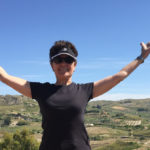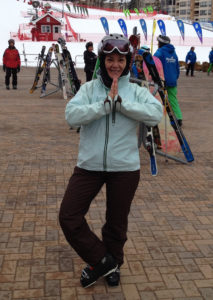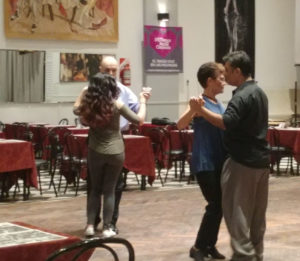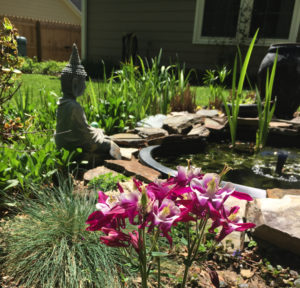 Like many people, I came to yoga in the 1990s mostly out of curiosity. And, like many people, I was interested in yoga for its physical benefits. For me, yoga’s best offer was a subtle promise to stretch my spine. As a short, small-boned woman whose grandmothers and aunts all had the shrimp-backed, sure signs of osteoporosis, this had great appeal. Any help with concentration and attention would be a bonus. Surprisingly, there were other unexpected benefits.
Like many people, I came to yoga in the 1990s mostly out of curiosity. And, like many people, I was interested in yoga for its physical benefits. For me, yoga’s best offer was a subtle promise to stretch my spine. As a short, small-boned woman whose grandmothers and aunts all had the shrimp-backed, sure signs of osteoporosis, this had great appeal. Any help with concentration and attention would be a bonus. Surprisingly, there were other unexpected benefits.
In a previous post, I wrote about three wonderful things that are particular to yoga and can be widely achieved: improved posture, overall body awareness, and enhanced mental focus. I truly believe this, keeping in mind that yoga is a practice. We are all practicing, improving, working toward these goals. Yes, I do stand taller and straighter; keep my spine flexible to combat kyphosis; and use breathing techniques to help me calm my busy mind. Several of my students have shared these same revelations. I also believe I’ve become a kinder, more introspective person. (Coincidental? Maybe, maybe not.) Many people have espoused these benefits; they are a well-documented part of the general doctrine. My surprising “aha!” moments have come when I am far from the mat while skiing, dancing, and even gardening. Who knew?
Yoga and skiing
Chair pose (Utkatasana). Need I say more? Skiing is like doing a Chair pose with your arms out front …all the way down the mountain. A hockey stop ends in a Chair pose with a twist. Practicing Chair pose, in all its variations, is a great way to train for skiing. Try slowly rising up on your toes and back down; it will challenge you to use your core to keep your weight centered and balanced.
 Oh yes, balance. That’s another biggie. Every standing pose, whether on one or two feet, improves your balance in every situation. Skiing is one situation where you really need it.
Oh yes, balance. That’s another biggie. Every standing pose, whether on one or two feet, improves your balance in every situation. Skiing is one situation where you really need it.
All twists, in any position, will help you with upper and lower body independence, so you can keep your torso facing the down the fall line while your skis go across the mountain. Want smoother, more rhythmic turns? Try following your breath: inhaling as you unweight your skis and extend, exhaling as you pressure your skis to turn. With luck, you might find that magic zone, that meditative state, where it all comes together and you lose yourself in the experience.
After skiing, I enjoy any version of Hero (Virasana) or Camel pose (Ustrasana). They stretch your quads, expand the front of your body, and open your ankles, which were kept in a flexed position in ski boots all day. These come highly recommended…by me.
Yoga and dancing
 Posture, balance, foot and leg strength, contra body movement. All of these are key factors in dancing, and all are improved with yoga. Mountain pose (Tadasana) is fundamental, while lunging poses (like this High Lunge) build leg strength, balance, and stretch the back foot. Floating your movements on your breath – like taking your full inhale and exhale to raise and lower your arms — will add grace to your technique in all slower dance styles.
Posture, balance, foot and leg strength, contra body movement. All of these are key factors in dancing, and all are improved with yoga. Mountain pose (Tadasana) is fundamental, while lunging poses (like this High Lunge) build leg strength, balance, and stretch the back foot. Floating your movements on your breath – like taking your full inhale and exhale to raise and lower your arms — will add grace to your technique in all slower dance styles.
Twists separate your torso from your hips, helping with contra body technique, rotational movements like spins and turns, and Latin motion. Try a seated twist (Ardha Matsyendrasa) or relax into a supine version (Supta Matsyendrasa). As a follower, I found I needed to get out of the thinking, anticipating mind to be more receptive to my partner’s leads. I think of it as auto-pilot and (again) the magic of yoga has helped me to disconnect and still be present.
My favorite pose after dancing is Legs-Up-The-Wall (Viparita Karani). My favorite treat after dancing is ice cream. (I know… it’s unrelated.)
Yoga and gardening
 Yup, even gardening. So much of gardening is a version of a Standing Forward Bend (Uttanasana) or a cross between Table (Bharmanasana) and Child pose (Balasana). Yoga has trained me to keep my knees soft and rely on my core muscles when bending. This takes some pressure off my lower back and is mandatory for any lifting, of which there is a lot. Gardening also involves a lot of up and down. Flow sequences, like this Sun Salutation, help with the transition from standing to other positions.
Yup, even gardening. So much of gardening is a version of a Standing Forward Bend (Uttanasana) or a cross between Table (Bharmanasana) and Child pose (Balasana). Yoga has trained me to keep my knees soft and rely on my core muscles when bending. This takes some pressure off my lower back and is mandatory for any lifting, of which there is a lot. Gardening also involves a lot of up and down. Flow sequences, like this Sun Salutation, help with the transition from standing to other positions.
While you might not use Plank or Cobra while planting your dahlias or tomatoes, these poses build overall strength required to safely, and repeatedly, move yourself up and back down.
Post-gardening demands a hot bath (it’s rather dirty) and benefits from any restorative pose that opens your chest and relaxes your back. I like Bridge pose (Setu Bandhasana) followed by a long resting pose like Corpse (Shavasana) with pillows under my back and beneath my knees. Ahhhhh.
Note: This post comes from the accidental-goddess website.
